Bread is a daily foodstuff for many people and if you are following the low FODMAP diet, you are probably wondering how to choose low FODMAP bread? This article takes you through what you need to know about wheat bread (and other gluten-rich breads), gluten-free bread and sourdoughs, in relation to the low FODMAP diet.

- Bread & FODMAPs
- Wheat Bread & FODMAPs
- Do You React To Fructans or Gluten or Something Else?
- Sourdough Bread & FODMAPs
- Gluten-Free Bread & FODMAPs
- Label Reading For LOFO Bread
- Low FODMAP Bread vs. Bread You Can Tolerate
- Bread Ingredients To Be Aware Of
- Common Questions About Bread & FODMAPs
- Let's Look At Sweeteners
- Lab Tested Certified Low FODMAP Bread
- Untested But Likely Low FODMAP Breads
- The Takeaway
- Choosing LOFO Bread Based On Science
Bread & FODMAPs
First, let’s talk about some basics.
- The low FODMAP diet is not a wheat-free or gluten-free diet. One major confusion revolves around wheat. It is a building block of many popular foods like bread, but also bagels, pizza, pasta, muffins, cookies, cakes, etc., so it is found in many recipes and prepared items and is hard to avoid – especially when it comes to bread.
- High-fructans grains, such as wheat, barley and rye are removed or greatly minimized from the diet during Elimination. This makes it hard to choose bread! Removing these grains from our diet will significantly reduce our intake of fructans and therefore lower our overall intake of FODMAPs. These grains also contain gluten, which means your gluten intake will also be reduced. The answer is not as easy as choosing gluten-free breads, which we discuss below.
- Wheat flour is the most common ingredient in conventional bread and it contains gluten, but also fructans, which are a FODMAP. During the Challenge Phase, RDs might choose to have you try a low FODMAP sourdough bread. Sourdough bread will be lower in fructans AND lower in gluten, but it still does contain gluten. Celiacs should steer clear, but many people with IBS can tolerate sourdough. Further Challenges can help you determine whether your IBS triggers are from fructans, gluten or both and to what extent.
- Labels can tell you a lot, but not everything. We will get into this in more depth later in this article, but suffice it to say that there have been breads that have been lab tested for FODMAPs, by either Monash or FODMAP Friendly, that do have low FODMAP serving sizes – and if you had just looked at the label, you would not have guessed that at all.
- Serving sizes count. This might be the most important takeaway of this article. In short, even whole grain wheat sandwich bread, that isn’t even sourdough, is low FODMAP in portions of 24 g or 1 average slice.
There are wheat-based breads that have low FODMAP serving sizes. You can jump to the end of the article to see a list, but we think there is helpful information in the article for you to read first…
Let’s break all these points down, one at a time.

Wheat Bread & FODMAPs
In your pre-FODMAP days (assuming you are not celiac) choosing bread was easy. What looked good? What were you in the mood for? Were you looking for sliced sandwich bread or a crispy artisanal baguette? No problem. You could have whichever you wanted.
Once you started the low FODMAP diet, the choices became more confusing. The first thing people want to know is, “What can I eat”? And questions about bread come up quickly.
As mentioned above, the low FODMAP diet is not a gluten-free diet, however, fructans, which are one of the FODMAP groupings, are very common being found in garlic, onions and wheat, to name a few ingredients. And wheat is the basis of most common breads, and wheat contains gluten.
So, traditional wheat bread – be it sliced bread or baguette – contains both fructans and gluten.
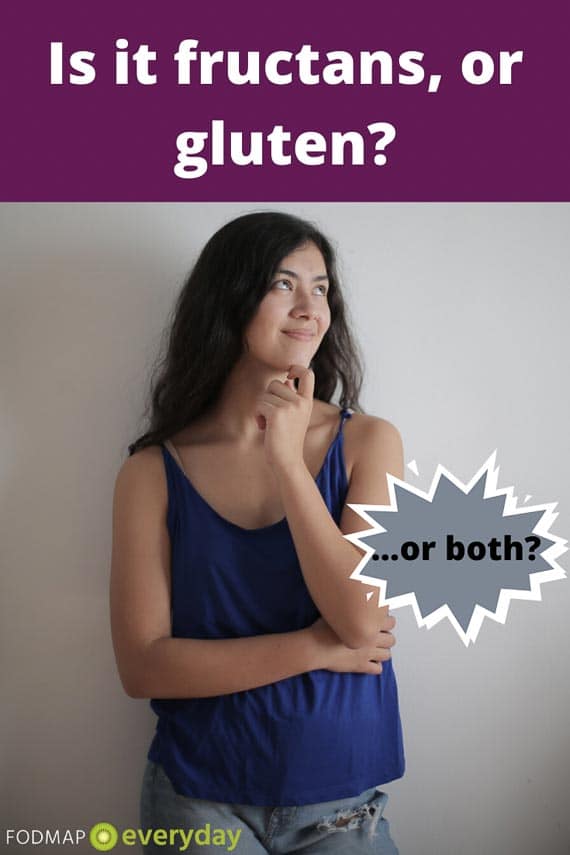
Do You React To Fructans or Gluten or Something Else?
This is a good time to ask this question – when you eat wheat bread, are your IBS triggers coming from the gluten or from the fructans or from something else found in wheat?
Believe it or not, most people do not know the answer before they go through a structured Elimination and Challenge Phase. To make it clear, gluten is a protein while fructans are sugars, and they are both found in the same grains.
A lot of people think that gluten is what causes their symptoms, but in most cases, it is the fructans (which are a FODMAP) rather than gluten, that are the culprits. In some more rare cases, even if you are not celiac (which should have already been determined) you might be sensitive to gluten, which is referred to as NCGS or non-celiac gluten sensitivity.
You could also potentially be sensitive to amylase-trypsin inhibitors (ATIs), which are a different kind of protein than gluten and are also found in wheat and other cereals containing gluten and fructans. There is no known way to isolate ATIs and gluten from one another when eating foods, so it is not possible to gauge one’s sensitivity by testing them separately.
During the FODMAP Elimination Phase, RDs will have you limit foods that are high in fructans. By doing this, your diet will also be lower in gluten, since the grains that contain fructans also contain gluten, but it will not be totally gluten-free. For example, sourdough bread and whole grain wheat sandwich bread are low FODMAP up to a certain serving size, but they still contain gluten. If you tolerate those foods well, you are most likely sensitive to fructans, and not gluten. If you you continue to have symptoms on a low FODMAP diet, RDs might have you trial a gluten free diet to see if this provides greater relief of symptoms.
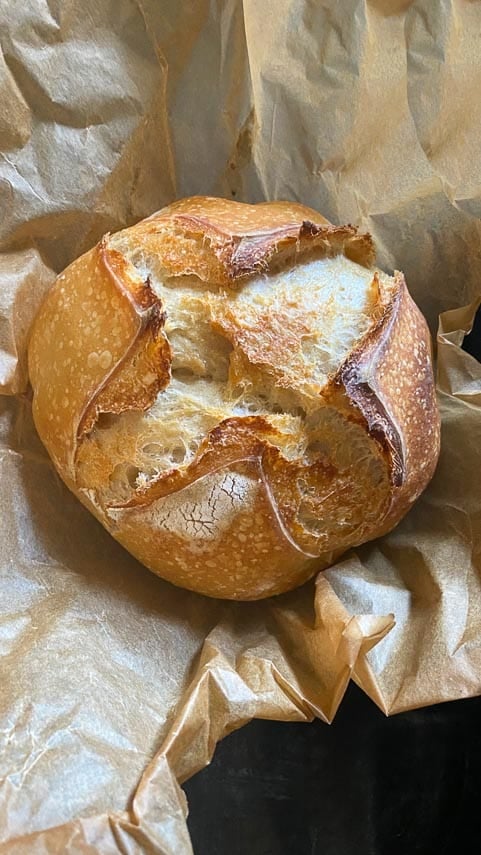
Sourdough Bread & FODMAPs
Now it is time to begin a discussion about traditional sourdough bread, which is wheat flour based (and therefore contains gluten, albeit a lower amount).
The fermentation process can lower both the fructan and gluten content by breaking down some of the carbohydrates and protein found in the flour.
Traditional sourdough bread is made with sourdough starter, which at its most basic level is made from wheat flour and water. The starter mixture is allowed to ferment, drawing upon wild yeasts and naturally occurring lactic acid bacteria, and this “starter” is used to raise and provide structure to the bread recipe. No packaged yeast is added.
This kind of bread is made from wheat flour and therefore contains gluten and is not suitable for celiacs, although might be more digestible for those with NCGS. During the fermentation process, which can range from a couple of hours to a day or more, the fructans present in the wheat are consumed during the fermentation process. Fructans, as with all FODMAPs, are carbohydrates. They act as food that feeds the fermentation.
The resulting sourdough bread contains gluten, albeit a lowered amount, and is also lower in fructans. Many people who thought they were sensitive to gluten find out that they can eat this type of sourdough bread and that it was the fructans that they were reacting to all along. (This was Dédé, living gluten-free for over 25 years when she didn’t have to be).
Current Sourdough Research
A March 2021 article in The International Journal of Food Sciences and Nutrition titled “Reducing FODMAPs and improving bread quality using type II sourdough with selected starter cultures” explains some current research.
Four breads were lab tested. Three breads made with white wheat flour and sourdough culture had an average reduction of fructans by 72%, with one reduced greater than 92%. The fourth bread made with yeast had a fructan reduction of about 20%, however, the fermentation time was maxed out at 6 hours for all of them.
What is the takeaway? That using sourdough culture yields a bread with lower fructans. That bread made with yeast also has lowered fructans. We do not know what the fructan reduction would be with a longer fermentation time but there is an indication that it would lessen even further. We also know from lab testing that sourdough breads that have the addition of yeast and a short 2-hour rise time can be low FODMAP (such as the Alpine Sour Rye, which was determined via direct communication with the company). So the final conclusion, that Monash agrees with, is that you can never know for sure without lab testing.
Gluten-Free Bread & FODMAPs
Perhaps you are sensitive to gluten and need gluten-free bread. There are many commercially prepared low FODMAP gluten-free breads but know that not all gluten-free grains and flours are low FODMAP, therefore you have to read labels and not just get pulled in by the “gluten-free” designation.
In addition, just because a bread is gluten-free and made with gluten-free grains, does not mean that all the ingredients are low FODMAP. This goes for any bread, actually.
GF Breads: Paleo, Low-Carb, High-Fiber, Keto & Otherwise
The low FODMAP diet is not meant to be followed along with any other restrictive dietary approach. That said, we know that many of you have an interest in paleo, low-carb, high-fiber, and keto diets. Many of these diets suggest a gluten-free approach and make recommendations about breads. Note that many GF breads that fall within these types of diets contain high FODMAP ingredients and are not necessarily compatible with a low FODMAP approach.
See our sections below on high FODMAP flours and low FODMAP flours to look for on labels to help you buy the right LOFO, GF breads.

Label Reading For LOFO Bread
Ah, labels, they tell us a lot, but not everything. Ingredients are listed from highest to lowest proportion on the label; hold onto this information as it is important.
High FODMAP Ingredients With Low FODMAP Serving Sizes
Honey, molasses and agave, as examples, are considered high FODMAP ingredients, yet they do have tiny 1 teaspoon lab tested and approved low FODMAP amounts. If a commercially prepared product lists honey high on the ingredient list, such as in a honey sweetened jam, then that would not be a prudent item to try from a FODMAP perspective.
But with breads, honey, agave or molasses are often used in very small amounts and they will be listed way down on the list. If the rest of the ingredients are low FODMAP, this should not necessarily be a deterrent, however, if there are several high FODMAP items listed, even in small amounts, then perhaps that bread is not the best choice.
Please review our article, High FODMAP Foods With Low FODMAP Serving Sizes.
Less Than 2%
Additionally, you might encounter a label that has a section towards the end of the ingredients that says, “Less than 2%”, and then there is a list of ingredients after that verbiage. It is generally accepted that if an ingredient is present in 2% or less that it is unlikely to cause a FODMAP reaction. Our article, How To Decipher “Natural Flavors” & “Spices” on Food Labels, explains this in depth. Your experience might vary.
For general background education, you might want to review these articles:
- How To Read A Certified Low FODMAP Product Label
- How to Read A FDA Nutrition Facts Label
- How To Read Food Labels For The Low FODMAP Diet With Confidence
- What Is A Low FODMAP Serving Size?
- Timing of Digestive Symptoms
Low FODMAP Bread vs. Bread You Can Tolerate
This is a very important section of this article. When an ingredient or a commercially prepared finished product is lab tested by either Monash or FODMAP Friendly and is guaranteed to be low FODMAP, there is no question that it is low FODMAP.
It doesn’t matter if the bread contains honey, or wheat, or fruit juice concentrate. If the bread has gone through a lab testing process and is sporting one of the certification icons (seen below in this article) then it is low FODMAP in the serving sizes recommended. ALWAYS pay attention to the serving sizes, though. That is very important, as always.
Reactions Are Individual
That said, you might eat the correct serving size of a certified low FODMAP bread and have an adverse reaction. Or, you might try a bread that would not conventionally be called low FODMAP and do just fine. How can this be?
Your digestive system is unique to you. Consider lab tests and the smartphone apps as excellent guides, however, what you discover about your own GI tract and FODMAP responses during structured Elimination and Challenge Phases are the ultimate answers. If something works for you, it works for you, no matter what apps and lab tests say and vice versa. If a bread does not agree with you, even if it is certified, then don’t eat it.
As we like to say, “You are not a lab”. What you are is your own best arbiter of what you can and cannot eat.
Serving Sizes Count
Whether you can tolerate a food or not, bread or otherwise, often comes down to amount. If you pick up a sticky honey jar and lick the residue off of your fingers, you might not react at all, but if you stir a generous teaspoon of honey into your tea, you very well might have a FODMAP reaction. One slice of sandwich bread, even wheat bread, might be okay, but a whole sandwich with two slices might put you over your FODMAP threshold. Review our article on Stacking for more information.
Recommended servings sizes are the place to start. Then you can adjust from there, depending on your own tolerances, which you will learn during your Challenge Phase.
Seemingly Conflicting Info
We want to note here, as our Success Team RD Kathryn Adel pointed out, that on the Monash University app there have been breads tested from various areas of the world and are labeled as such. You can find breads from the U.S., Germany, Norway, Australia, to name a few, and FODMAP levels vary for their respective breads.
Looking at white wheat, sliced sandwich bread, for instance, in the U.S. the low FODMAP amount is stated as 35 g and yet Norway is Red Light High FODMAP at 30 g. When no country is specified the low FODMAP amount is 24 g.
We understand that this seems confusing. But what has happened here is that certain breads were tested in a certain lab and yielded certain results. That’s it. If FODMAP Friendly had tested the same breads, results might have been different – higher or lower. Neither is right or wrong; different labs can yield different results – just like when you get blood work done! And of course, the breads were different. Always remember that what is important is how YOU react to a particular bread. We think that testing 1 slice or the equivalent of any type of bread during your Challenge Phase, once you are stable, is the best approach.
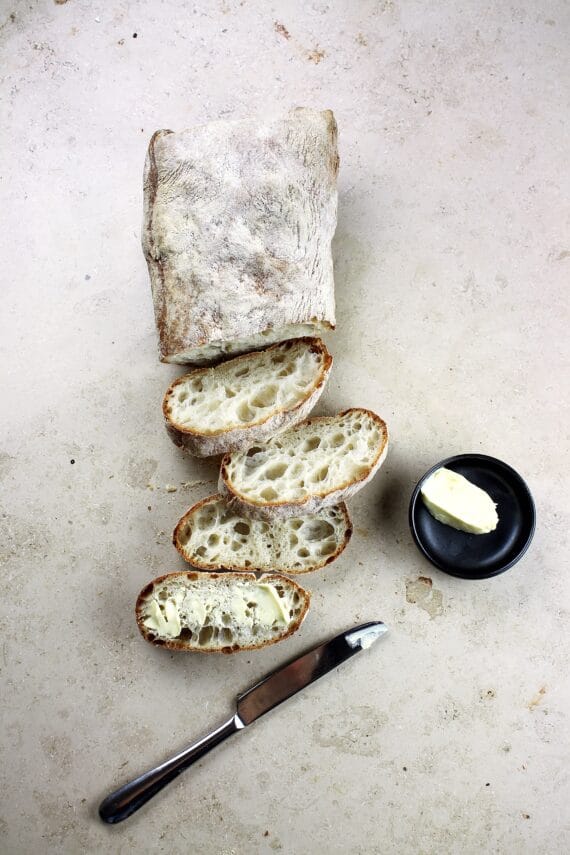
Bread Ingredients To Be Aware Of
If you make your own bread, or buy from an artisanal bakery, the ingredient list will be short and easy to understand: flour, water, salt. Maybe a sweetener, perhaps some yeast. And yes, yeast is low FODMAP.
But what about fruit juices or concentrates, wheat gluten or dextrose? What about sourdough breads with added yeast? Milk solids and dry milk powder are common, as is malted barley. And what about all those additives and preservatives like methylcellulose, monoglycerides, lecithin, inulin, chicory root fiber and other fibers, among other common ingredients?
Below we answer questions about these common bread ingredients:
Common Questions About Bread & FODMAPs
Here are some of the more common questions that we hear in regard to bread and FODMAPs.
How can I tell if a sourdough is low FODMAP?
At one point it was believed that a sourdough bread had to go through a long, slow rise in order for enough fructans to be consumed to be low FODMAP. In addition, it was believed that no yeast should be separately listed on the label as it was thought that yeast was added to hasten the rising process, and therefore the bread would still be too rich in fructans. We now know this not to be the case. There are lab-tested and certified Low FODMAP sourdough breads that contain yeast and that have a very short, 2-hour rise (such as Alpine Sour Rye, which was determined with communication with the manufacturer), so this means shopping by label reading is a bit of an unknown proposition – unless you are sticking with certified low FODMAP products.
If you find a sourdough that you want to try, we suggest trying 1 slice or approximately 35 g during your Challenge Phase and assess your own tolerance, which is what is the most important thing.
For a deep dive into some research, read “Determination of FODMAP contents of common wheat and rye breads and the effects of processing on the final contents“.
Are all gluten-free breads low FODMAP?
No. All gluten-free breads are not low FODMAP. LOFO and GF are not the same thing and we have two great examples. FODMAP Friendly lab certified low FODMAP Alpine Breads Sour Rye contains wheat and rye flours, is certified low FODMAP, yet contains gluten. On the other hand, Julian Bakery Paleo Bread is gluten-free but contains high FODMAP coconut flour, added fibers and other untested and/or high FODMAP ingredients. In addition, gluten-free breads often have high FODMAP additives, such as inulin.
What are inulin, FOS and chicory root?
Inulin, FOS (fructooligosaccharide) and chicory root are high FODMAP additives commonly found in prepared foods. Inulin and FOS are fibers derived from chicory root, which is why you often seen them mentioned together in FODMAP literature.
These additives can provide bulk and structure to a prepared item, a creamy mouthfeel and even sweetness and are found in everything from breads and baked goods to yogurts, “low carb” products and even supplements, so you have to read labels. We recommend that you avoid them.
What are low FODMAP flours and starches that I should look for in a low FODMAP gluten-free -bread?
Here is a list of low FODMAP flours, grains and starches that are appropriate for low FODMAP breads:
Low FODMAP Gluten-Free Flours & Starches
- Arrowroot
- Buckwheat flour
- Cornmeal, corn flour, cornstarch & masa harina
- Green banana flour
- Maize flour
- Millet flour
- Oat bran & flour
- Potato flour or starch
- Quinoa flour
- Rice bran, flour or starch, brown & white
- Sorghum flour
- Tapioca flour or starch
- Teff
What are some high FODMAP flours and grains that I should look out for?
Great question! PLEASE NOTE that there are breads that contain small amounts of these flours, grains and ingredients and yet the breads are low FODMAP in small serving sizes – there are even certified low FODMAP breads that contain them – but this list will alert you to make a note of an ingredient to assess the product further in case it is not certified.
Please use your Monash University and FODMAP Friendly smartphone apps while navigating these lists. There are items on the high FODMAP list below that do have small low FODMAP amounts and/or are tolerated by those with IBS, however, they are generally considered high FODMAP and ingredients to be mindful of (such as nut flours and psyllium husks).
Keep an eye out for:
High FODMAP Flours & Grains
- Amaranth flour
- Bean flours
- Coconut flour
- Eikorn
- Emmer
- Freekah
- Kamut
- Lupin
- Nut flours
- Psyllium husks
- Rye flour
- Soy flour
- Triticale
Can I eat rye bread on the LOFO diet?
If you look up rye flour on the Monash app, you will see that it has a Red Light High FODMAP designation. As with ALL foods that contain FODMAPs, processing and serving size can alter that FODMAP standing. Alpine Sour Rye Bread has been lab tested and certified low FODMAP by FODMAP Friendly in serving sizes of 2 slices or 80 g. This bread contains wheat as well as rye and is a perfect example of how the process of creating a finished product and the serving size can yield a low FODMAP product even though it includes what we typically consider to be high FODMAP ingredients.
Is coconut flour low FODMAP?
No. It is not. It has been lab tested by both Monash University and FODMAP Friendly, down to a 3 tablespoon (20 g) sized serving and it is considered high FODMAP by both testing labs. We see “low FODMAP” recipes all the time that contain coconut flour and simply put, those are not low FODMAP recipes. This flour is getting its own entry because we receive many inquiries about it, which I assume is because people see “low FODMAP” recipes containing it all the time. Please check the reliability of your sources and always defer to the lab testing performed by Monash and FODMAP Friendly.
What about coconut sugar?
Coconut sugar is low FODMAP in 1 teaspoon (4 g) amounts. In this way it is very similar to honey, agave and molasses in that it can appear in very small amounts in recipes and products and the resulting item could be low FODMAP. In bread, this would be more possible than in a cake or cookie, for instance, where more sweetener per serving would be required. If it is present in 2% or less on the label you will most likely be fine, but this is an ingredient to be aware of. As always, your tolerance is what counts.

Let’s Look At Sweeteners
We have a great article for you already called Explore An Ingredient: Sugar. In that article you will find a lot of information on a wide array of sweeteners including stevia, honey, and all kinds of granulated sugars and more. That article also addresses non-nutritive sweeteners, like sucralose and stevia, and gut health.
Here I will address some sweeteners that are particularly common in commercially prepared breads, in alphabetical order:
Agave: Monash University has lab tested agave, dark and light, and it is low FODMAP in 1 teaspoon (5 g) amounts. There should be very small amounts present in typical (non sweet) breads. Test during Challenge Phase to assess tolerance, choosing breads that list it low down on the label.
Cane Sugar: Also evaporated cane sugar, sugar, beet sugar, brown sugar, cane syrup: All of these sugars are low FODMAP.
Corn Syrup: Please read our article on Corn Syrup vs. High Fructose Corn Syrup (HFCS). They are not the same thing. Corn syrup is low FODMAP. HFCS is not.
Dextrose: Dextrose is considered a low FODMAP sweetener because it does not contain excess fructose. You can find it in products like the FODMAP Friendly lab tested and certified low FODMAP line of Helga’s breads.
Fructose: Fructose is high FODMAP.
Fruit Sugar: Fruit sugar is high FODMAP, being high in fructose.
Golden Syrup: Monash University has lab golden syrup and it is low FODMAP in 1 teaspoon (7 g) amounts. There should be very small amounts present in typical (non sweet) breads. Test during Challenge Phase to assess tolerance, choosing breads that list it low down on the label.
Glucose Syrup: Low FODMAP.
Glucose-Fructose: Often found on Canadian labels. This is high FODMAP.
High Fructose Corn Syrup (HFCS): High FODMAP. Please refer to our article.
Honey: Monash University has lab tested honey and it is low FODMAP in 1 teaspoon (7 g) amounts. There should be very small amounts present in typical (non sweet) breads. Test during Challenge Phase to assess tolerance, choosing breads that list it low down on the label.
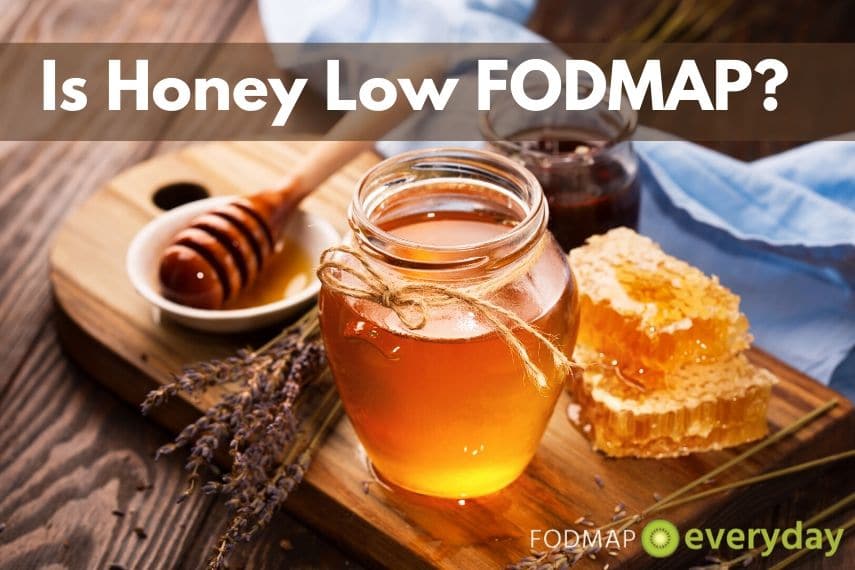
Invert Sugar: Invert sugar has been tested by FODMAP Friendly and they give is a “Pass” at 10g servings.
Maple Syrup: Low FODMAP.
Molasses: Monash University has lab tested molasses and it is low FODMAP in 1 teaspoon (5 g) amounts. There should be very small amounts present in typical (non sweet) breads. Test during Challenge Phase to assess tolerance, choosing breads that list it low down on the label.
Monk Fruit: There are products that contain monk fruit that have been lab tested and certified as low FODMAP, but we do not have any information about distinct levels on its own. Test during Challenge Phase to assess tolerance, choosing breads that list it low down on the label.
Polyols: Also referred to as sugar alcohols. These would include mannitol, sorbitol, xylitol and maltitol – all high FODMAP sugar alcohols. Erythritol is a sugar alcohol as well, but is absorbed better in the small intestine than the others and is not considered a FODMAP at this time.
Rice Malt Syrup: Monash University has lab tested rice malt syrup and give it a low FODMAP rating at 1 Australian tablespoon or 28 g. They further explain that no FODMAPs have been detected in this food.
Stevia: Stevia is low FODMAP.
Sucralose: Sucralose has not been lab tested but it is considered to be low FODMAP.
Artificial Sweeteners & Gut Health
Even though non-nutritive sweeteners like monk fruit, sucralose and stevia are considered to be low FODMAP, they could potentially change the composition of the gut microbiota. Therefore, it is preferable to consume them in moderation. Please read our Explore An Ingredient: Sugar for more information.
Is modified food starch low FODMAP?
Yes, modified food starch is considered low FODMAP because it is a resistant starch; these starches do not ferment quickly in the gut the way FODMAPs do.
What is wheat gluten and is it low FODMAP?
Also called vital wheat gluten, wheat gluten this is a protein naturally found in wheat. As it is a protein and not a carbohydrate, it is low FODMAP. As of May 2020, Monash has lab tested vital wheat gluten and designates a low FODMAP serving size of ¼ cup or 30 g. Note that it is not gluten-free. There are even certified low FODMAP products that contain wheat gluten, such as Baker’s Delight Wholegrain Rolls.
How about soy flour? Soy products are confusing to me.
Soy can be confusing because there are soy products that are consider low FODMAP and those that are considered high FODMAP. We have a few articles on soy products that you can read for general info, but here we are focused on soy flour. FODMAP Friendly has lab tested soy flour and given it a “FAIL” at 50 g; it is very high in fructans and GOS. That said, we know that there are certified low FODMAP products and breads, from both Monash and FODMAP Friendly, that contain soy flour, so it is a matter of amount. Review our article on What Is A Low FODMAP Serving Size?
How about soybean oil?
Soybean oil is a fat and does not contain any FODMAPs.
If a bread contains whey, is it low FODMAP?
Whey contains lactose. Lactose is a FODMAP. Most likely any whey added to bread is in a very small amount. It will come down to the amount in the bread and your individual tolerance. This is not to be confused with whey protein isolate, which is a protein, low FODMAP and found in Low FODMAP protein powders.
If a bread contains milk solids, dried milk powder, lactose or lactose monohydrate is it low FODMAP?
These dairy milk products contain lactose, which is a FODMAP. According to Monash, research suggests that most people with lactose intolerance can tolerate 12 to 15g of lactose per day and possibly even more if the lactose consumption is spread throughout the day rather than in a single sitting.
Many medical professionals recommend looking at the list of ingredients. If the milk products is low on the list, it is less likely to trigger a lactose FODMAP response. Your unique tolerance is what counts. Check the FDA Nutrition Panel. If sugars are 1 g or less per serving, it is unlikely that there is excessive lactose present.
And BTW, lactic acid, casein and milk protein are derived from milk, but are low FODMAP.
Is raisin bread low FODMAP? It was always my favorite.
Monash University has lab tested “Raisin Toast” and it is high FODMAP even at 1 slice (37 g). Note that Monash has lab tested raisins and they are low FODMAP in 1 Australian tablespoon portions of 13 g. Raisin bread brands will vary. You could try 1 slice during your Challenge Phase to assess personal tolerance. We believe that Monash tested classic, wheat-based raisin bread. You could try that, or try a slice of Udi’s Gluten Free Cinnamon Raisin Bread.
What is lecithin?
You might see lecithin on bread labels and very often on chocolate labels. It is typically added as an emulsifier and is considered low FODMAP, regardless of its source. It might be labeled as lecithin, soy lecithin, sunflower lecithin or even lecithin derived from egg.
What are monoglycerides and diglycerides?
Monoglycerides and diglycerides are emulsifiers and considered low FODMAP, especially in the amount they would be present in a prepared food. Do not confuse them with monosaccharides and disaccharides, which are FODMAPs.
What is datem? It is in a lot of prepared breads.
Datem, diacetyl tartaric acid ester of mono- and diglycerides, and also known as E472e, is an emulsifier used to strengthen the gluten network in doughs of breads and baked goods. It improves texture. Datem has not been tested for FODMAPs per se, and is not considered a FODMAP issue, however, some folks with IBS could experience negative gut side effects from this or other additives. Test products containing datem during your Challenge Phase to assess your own reactions.
What does “wholemeal” mean?
Wholemeal is a term that refers to a whole grain that has been ground into a flour, or meal. There have been many wholemeal products, including breads, that have been lab tested by Monash that are low FODMAP. Please refer to the app for more information.

What does “wholegrain” or “whole grain” mean?
A whole grain is comprised of three main elements: bran, germ and endosperm. If bread is “wholegrain” or “whole grain”, the product either contains the grain in its whole form, or it is made from a flour that is created by grinding down all parts of the seed – bran, germ, endosperm. There have been many wholegrain products, including breads, that have been lab tested by Monash that are low FODMAP. Some are even Certified low FODMAP brands of breads. Please refer to the app for more information.
What does “whole wheat” mean?
“Whole wheat” means that the entire wheat grain is in the product, either in its whole form or ground into a flour as described above. Make sure that the label says “100% whole wheat” when looking for a whole grain product. This means your bread should contain at least 16 grams of whole wheat. You can also check the ingredient list and the first ingredient should have the word “whole” preceding “wheat”.
What is “wholegrain bread”?
“Whole grain bread” is a bread made using any whole grain, such as oat, rice, wheat or what have you. “Whole wheat bread” would always contain the whole wheat grain.
What is “multi-grain” bread?
Any product that calls itself “multi-grain” or “multigrain” contains more than one type of grain in its manufacture. It does not mean that any of those grains are whole grains. There have been many multigrain products, including breads, that have been lab tested by Monash that are low FODMAP. Please refer to the app for more information.
Can I eat spelt bread? I am confused about spelt.
We understand your confusion! Looking at spelt information in the Monash app is dizzying. Spelt flour has been lab tested and is considered high FODMAP, but if you look at the amount, it is large. For instance, wholemeal spelt flour is high FODMAP at 2/3 cup or 100 g. Sieved organic spelt flour, however, is low FODMAP in the same amounts. This tells us, in part, that the bran, which would be somewhat or largely removed in the sieved product, is FODMAP rich. Then within the small print of some entries within the Monash app they mention that the fermentation of the sourdough process can lead to a low FODMAP spelt bread, and indeed there are several low FODMAP sourdough spelt breads listed.
BUT, and this is a big but, and is where confusion reigns, there is also an entry for 100% spelt bread – not sourdough – and it, too, is low FODMAP even at 2 slices or 70 g. Then, we can also find Inewa Spelt Bagels, which are lab tested and certified as low FODMAP.
So, what to think?
If a product is lab tested and certified, like these bagels, or Pure Life Bakery Organic Sprouted Spelt Bread, then we know for sure that the product is low FODMAP in the serving sizes suggested. In terms of spelt bread products that are not lab tested, we suggest starting with the equivalent of 1 slice or about 35 g. YOUR individual reactions, assessed during your Challenge Phase are the ultimate arbiter.
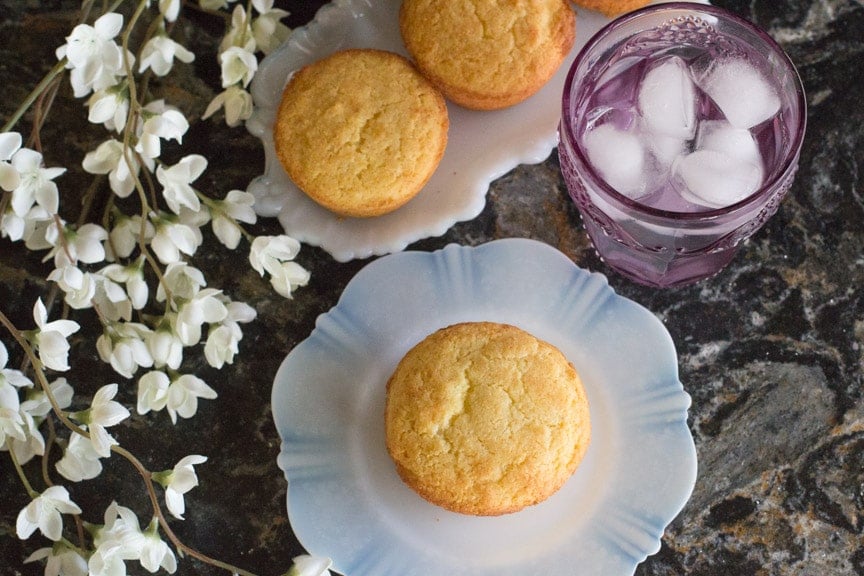
Can you talk about “cornbread” and “corn bread”?
This is an interesting topic as “cornbread” in the U.S. signifies a very cornmeal-rich bread, made without yeast, that has a somewhat crumbly texture. It is usually cut into blocky squares or made into muffins and is often served alongside chili, stews and beans. It is not a sandwich bread in that it cannot be cut into thin slices to encase typical sandwich fillings. This is of interest because the image of “corn bread” in the Monash app is of a standard loaf shaped bread, that is vaguely yellow, ostensibly from cornmeal.
We know that Monash tell us to use their images to help understand the entries and this might be a situation where there is a cultural difference. In the U.S. we have a yeast-raised, sliceable sandwich bread that contains cornmeal, that looks just like that image and is called Anadama bread. As with most cornbreads of all types, it is typically made with both wheat flour and cornmeal.
So, the problem is that because every cornbread is different, whether it is a U.S. style or sliceable sandwich bread style, and will most likely contain wheat and cornmeal, and no brand is given to us by Monash so that we may view an ingredient list, we have no idea what that bread in the image is. They state that a low FODMAP serving is 1 slice at 35 g. So again, it comes down to serving sizes. Our recommendation is that if you encounter a sliceable, sandwich “corn bread” that you try 1 slice. If you are looking for U.S. style cornbread, come try our Pumpkin Cornbread or Cornbread Muffins.
If malted barley or malt flavoring is listed on an ingredient list, is the bread low FODMAP?
Malted barley and malt flavoring or malt extract are common ingredients in prepared foods. Firstly, note that barley is not gluten-free, so if you need GF, then these ingredients will be a red flag. In terms of FODMAPs, we know there are lab tested certified low FODMAP products that do contain barley malt, so in some small amount it is low FODMAP, such as the Monash University lab tested and certified Inewa Bagels. As of May 2020, Monash has lab tested “malt extract” and gives it a Green Light at ⅓ an Australian tablespoon (13 g). It becomes Moderate for FODMAPs quite quickly at 16 g. The key, as usual, is amount ingested. Choose a bread where it is lower down on the list and test it when you are stable during your Challenge Phase to assess personal tolerance.
Are breads that contain high FODMAP ingredients such as barley low FODMAP?
There is no absolute answer. Alpine Spelt & Barley Sourdough is lab tested and certified low FODMAP by FODMAP Friendly. The serving size is a generous 2 slices at 80 g. The process of creating a sourdough lowers the fructan (FODMAP) load. If a bread contains barley, is not certified and is also not a sourdough we suggest proceeding with caution.
What if a bread contains fruit juice or fruit concentrates?
There are many fruits that are low FODMAP. In fact, strawberries, grapes and oranges are even NO FODMAP, but it is typical of fruit to increase in FODMAP load when it is processed – and this includes when it is made into commercial juice, dried and certainly concentrated.
For instance, according to Monash University, freshly squeezed orange juice contains no FODMAPs, but commercially prepared orange juice does contain FODMAPs. This would lead one to believe that fruit juice concentrates would be high FODMAP, but we also know that there are lab certified products that contain fruit and fruit juice concentrates and therefore we know that it is a matter of amount.
As an example, Fody Blueberry Almond Snack Bars contain apple juice concentrate, and yet they are certified low FODMAP by Monash University. So, if you are stable and in your Challenge phase and come upon a bread that is not lab tested but has fruit juice concentrates on the label, you could consider trying it if the juice ingredient is low on the list. Please review this article which delves into label reading.
What is methylcellulose? I see it on labels all the time.
Methylcellulose is a non-fermentable fiber with gel-forming properties. It is often added to improve texture in packaged foods such as bread and even ice cream. It is considered low FODMAP. As an aside, it is also used as a supplement (Citrucel) to soften stool and can be an aid for those with IBS-C. Please work with your dietitian in regard to this use.
Is psyllium low FODMAP? I see it on so many labels.
Psyllium on its own is not listed on either the Monash or the FODMAP Friendly apps. Monash does list “Flakes of Rice, with Psyllium, gluten free” and gives it a High FODMAP Red Light designation at a large amount of ½ cup (25 g). However, and this is important, there are lab tested and certified low FODMAP products that contain psyllium, so we know that it is matter of amount. For instance, psyllium husks are in Sanitarium Gluten Free Weet-Bix, Helgas Gluten Free Traditional White, their Mixed Grain and Wholemeal as well as Genius Gluten Free Mindblowingly Soft White Bread – all certified low FODMAP products.
Is “plant fiber” low FODMAP?
In general, when you see the word “fiber” you should be cautious as many are high FODMAP. That said, there are lab tested certified low FODMAP products that contain “plant fiber” so we know it is possibly a matter of amount.
What is maltodextrin and is it low FODMAP?
Maltodextrin is a white powder derived from grains and starches such as wheat, corn and even potato and is added to prepared foods as a stabilizer, thickener and sweetener. It is often used in the manufacture of breads, baked goods, meat substitutes, salad dressings and even sweets and energy drinks, sports drinks and gels. Maltodextrin appears to be tolerated by many with IBS, however, it is not strictly considered low FODMAP and of course individual results may vary. Speak with your RD about trying breads that contain maltodextrin during your Challenge Phase so that you will have a better idea of whether to avoid or not for yourself personally.
Lab Tested Certified Low FODMAP Bread
PLEASE use both the Monash University and FODMAP Friendly smartphone apps to view current lists of lab tested and certified low FODMAP breads. There are many! When shopping in the store, look for these icons below on your bread products.
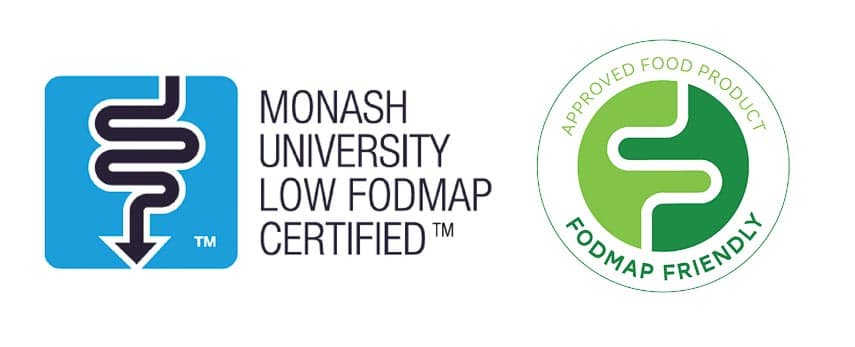
The Monash app, in particular, has a very long listing of wheat-based breads that they have lab tested and you can easily reference whether they have low FODMAP serving sizes. Many do!
Untested But Likely Low FODMAP Breads
Here we have listed some of the most popular un-tested breads that low FODMAP diet followers seem to tolerate well and that are most likely low FODMAP. Of course, your own tolerance may vary. More come to market all the time, so keep checking your grocery shelves. Also, manufacturers can change ingredients, so always check labels before buying.
Special Note On Fiber & LOFO Bread
Of note, fiber intake is often compromised when adopting a low FODMAP diet, which can have adverse effects on the beneficial gut bacteria and IBS symptoms. Therefore, choosing low FODMAP starches that are high in fiber can be helpful. To help you, the breads below that have one asterisk next to them are a good source of fiber, meaning that they contain 2.5 g of fiber or more for a serving of 2 regular size slices or an approximate portion of 50 g. Those that have 2 asterisks are considered a high source of fiber, meaning that they contain at least 5 g of fiber for the same serving size.
- Abbott Village Bakery GF Rustic White
- Abbott Village Bakery GF Soy & Linseeds *
- Against The Grain Gourmet Gluten Free Baguettes
- Burgen GF Soy & Linseed *
- Burgen GF Sunflower & Chia *
- Canyon Bakehouse Gluten-Free Country White Bread
- Coles Finest Stonebaked Sourdough Baguette
- Coles Finest Stonebaked Sourdough Multigrain Vienna
- Coles Finest Stonebaked Wholemeal Sourdough
- Country Life GF Grains & Seeds *
- Country Life GF White
- Edwards Organic Spelt Wholemeal Grain **
- Food for Life Gluten Free Brown Rice English Muffins
- Food for Life Gluten Free Multi Seed English Muffins
- Franz Gluten Free Bagel
- Franz Gluten Free Great Seed Bread
- Franz Gluten Free 7 Grain
- Franc Gluten Free Mountain White Bread
- Glutino Gluten Free White Bread
- Litchenstein’s GF Bread
- Litchenstein’s GF Country Loaf
- Litchenstein’s GF Soy & Linseeds
- Litchenstein’s Wholemeal Sourdough Spelt Bread **
- liveGfree Gluten Free Whole Grain Bread *
- Sam’s Choice Gluten Free Classic White Bread
- Trader Joe’s Gluten Free Plain Bagels (not the Everything flavor, which contains garlic and onion)
- Trader Joe’s Gluten Free White Sandwich Bread
- Udi’s Gluten Free Bagels
- Udi’s Gluten Free White Sandwich Bread
- Udi’s Gluten Free French Baguettes
- Vitality Bakehouse Wholemeal Spelt & Chia Sourdough
The Takeaway
There are many breads that can be enjoyed on the low FODMAP diet.
They range from low FODMAP compliant gluten-free options, to sourdough, to those based on wheat flour as well as those made with other grains, gluten-free and otherwise. Here are our suggestions for best buying practices:
- Look for Monash University and FODMAP Friendly Certified Low FODMAP breads. This guarantees that the breads are low FODMAP in recommended serving sizes.
- Learn to read labels and to recognize potentially high FODMAP ingredients. Remember that if a high FODMAP ingredient, such as honey, is low down on the ingredient list, you do not have to necessarily disregard the bread without trying it.
- When in doubt you can try the equivalent of 1 “slice” or about 30 g of bread as a portion. Our research has shown us that serving size is integral across the board, whether we are looking at GF, wheat based, sourdough or otherwise.
Remember: Just because something is lab tested as low FODMAP does not mean it will agree with you. Feel free to test your own tolerance, once you are stable and in your Challenge Phase.
Choosing LOFO Bread Based On Science
All of the information contained in this article is based upon guidelines presented by Monash University and FODMAP Friendly and co-written by Dédé Wilson and Kathryn Adel MS, RD, CSSD, LD, both of whom are Monash trained. Dédé is also FODMAP Friendly Accredited.
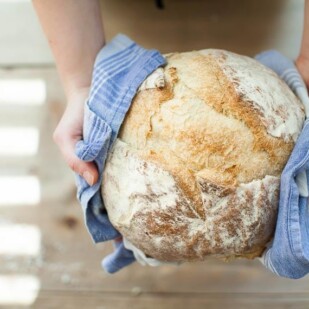
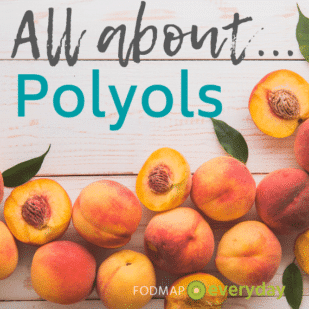





Hi! Thanks for this article, it was extremely informative. I’ve recently taken up the habit of baking sourdough bread and I’ve found very mixed opinions on which are and are not LOFO. I know that if it hasn’t been tested in a lab, there is no definitive way to know whether or not something is LOFO, but I was wondering if in general, a regular white flour sourdough bread can be good. I’ve been making myself crazy trying to find a good spelt sourdough recipe thinking that this was the only LOFO option but based on this article, it seems regular white wheat may be ok too. Would that be correct?
Can be? Yes. Whether a recipe calls for all-purpose flour (which is wheat based) or bread flour (which is wheat, but higher in gluten), both have the potential to have reduced fructans as described in the article.
Thank you for this article. I am on day 18 of the elimination phase. Eating GF bread now, but wanting to reintroduce my homemade bread. It has 5 ingredients including 1/2 cup of dark rye, AP wheat flour and a homemade poolish. Does this qualify as a sourdough bread? I have never felt it was a trigger.
A few thoughts: rye and wheat can be tricky from a FODMAP perspective, however you also say you do not think they have been triggers. One great thing about a strict Elimination phase and structured Challenge Phase is that it is not uncommon for folks to discover triggers they hadn’t noticed before and also realize that foods they thought were triggers, are not! And then there is the matter of sourdough itself and the fact that if it is lab tested, you know its status for sure, otherwise we are taking educated guesses. Without dictating from a medical advice perspective, I will say this – if I were you I would say, hey, Elimination is brief. For that period I would stick with proven low FODMAP items and then once stable and in my Challenge phase (which is mere weeks away) I would make my sourdough and give it a try. Run this by your medical team and see what they think. A GI might not have much to say; a FODMAP trained RD would. GREAT question by the way. Thank you for reaching out – and good luck! It is a lucky household to have a bread baker!
Hi, I’m on the elimination part of low FODMAP. I just bought the UDIs GF white sandwich bread. The first ingredient is pea starch! How can this be Low FODMAP, or is it?
A couple of things. First of all many starches are low FODMAP, but more to the point, the Udi’s White sandwich bread that we recommend has these ingredients: WATER, TAPIOCA STARCH, BROWN RICE FLOUR, CANOLA OIL, EGG WHITES, POTATO STARCH, MODIFIED FOOD STARCH, TAPIOCA MALTODEXTRIN, DRIED CANE SYRUP, TAPIOCA SYRUP, YEAST, GUM (XANTHAN GUM, SODIUM ALGINATE, GUAR GUM), SALT, LOCUST BEAN GUM, CULTURED CORN SYRUP SOLIDS AND CITRIC ACID (MOLD INHIBITOR), ENZYMES. CONTAINS: EGG.
Can we FODMAPers have Dave’s Killer Bread?
There is not just one kind. But looking at the brand in general, these would best be saved for after Challenge Phase when you know your tolerances.
Tralete español por favor
Sugiero usar Google Translate para ayudarlo.
Thank you SO much for this article! It’s incredibly informative and so helpful! Thank you for all you put into this, it is greatly appreciated!
Gina, you made may day! As I wrote that article it kept growing…I think it is the longest on the site. But I thought what was contained was necessary. It truly means so much to me that folks like you have responded favorably! If I helped you, then my goal was accomplished.
Thank you for such a detailed article. I’ll most likely be coming back to this again.
I don’t know much about how bread is made (but more since reading this article!), and I’m still confused at the distinction of two separate reintroduction/challenge phases. I just want to make sure I’m purchasing the correct breads for each test, and would love to eventually add more bread into my diet instead of being afraid to try anything lest there be a hidden FODMAP.
For Fructans in grain foods, the Monash app suggests testing “Wholegrain Wheat Bread.” And later on in testing I will test Fructans + GOS with the Monash app suggesting “Wheat Bread.”
What distinction am I looking for in these two breads?
Thanks so much in advance for any guidance.
Thank you for the compliment on the article. It was a labor of love. Indeed the distinction is not clear. I suggest you ask Monash directly, as it would be very interesting to hear their answer. This is how they explain it on their website: “What about galacto-oligosaccharides (GOS)?
Like fructans, the term GOS refers to a family of molecules rather than one specific molecule. Food challenges for GOS have not been further separated in the app at this time. This is because GOS is predominately found in one food group (legumes). You may have noticed that some foods considered high in GOS are also high in fructans (including wheat breads, cashew nuts and red kidney beans). To address this, completing a separate food challenge for foods high in fructans + GOS is suggested in the app (especially if you enjoy these foods regularly). ”
You can usually get a quick(er) response by private messaging them through their Facebook page.
Thank you for this detailed and informative post. One question – is there a link to a recipe for the beautiful sourdough loaf credited to Robin?
Hi Barbara! I’ve been making variations using this wonderful very easy recipe from Alexandra Cooks – https://alexandracooks.com/2019/11/07/easy-whole-wheat-ish-sourdough-bread/
Make sure you follow her instructions closely the first time – and then you will be able to customize your approach and timing and combinations of flours. – And be sure to read through her site as she has other sourdough bread recipes and so much helpful information.
A Dutch oven is a must. I use a 2 quart one – they have reasonably priced ones at Bed, Bath and Beyond and Target. And parchment paper. And a digital scale. I can’t wait to see pictures of what you make! – Robin
Thank you very much, Robin. It looks a bit more complicated than the no-knead loaves I used to make, but less daunting than most sourdough recipes. I’ll give it a go!
Once you do it once it will become super easy! I literally spend a total of 10 minutes on the active part of making this bread each time. It’s essentially a “turn in the bowl 4 times” bread. With some resting periods in between. I usually start it in the late afternoon, then let it rise overnight, form it, throw it in the fridge until the evening and bake it for dinner – or flip that around and bake it for breakfast! Enjoy!
What about homemade Irish Soda bread, can it be low fodmap?
We have TWO recipes for you. One is richer than the other, but we love both.
As an academic physician I want to thank the authors for this valuable article. It is scientifically rigorous, very well written and organized and presented in a fashion that is very understandable. Well done and thank you
Thank you so much for the compliments and taking the time to write. This is a very popular article as it does contain a lot of info and can be very helpful. We know that this long form is not for everyone, but when there are so many nuanced and important points to hit, we think it is worth the effort.
I have been making sourdough bread about once a week for the past six months. I read that, like you mentioned, the longer the ferment the fewer the FODMAPS/ gluten that remains in the dough. I use only starter, bread flour, salt and water. After a quick dough turn every 30 minutes for several hours I pop it in the fridge overnight and then put it in the oven the following day, about 12 to 16 hours later after the refrigerated fermentation. I will typically have a slice or two of this bread per day and have no problems with stomach pain or the inevitable gas that plagues me whenever I eat any other type of bread product. I’m now experimenting with recipes for sourdough pizza crust and bagels and hope that I can soon eat those old favorites without pain or embarrassment.
Ann, sounds like you have really figured out how to have great bread and keep your triggers at bay. KUDOS! It is always gratifying when we learn our triggers and still figure out how to eat well.
I have found that all the advice in your emails does NOT deal with insoluble fibre as a major issue. I have problematic sensitivities to gluten, dairy, eggs, and all high insoluble fibre foods (which are very, very many). My diet is EXTREMELY limited. Your advice doesn’t help me. I could use some help. I do find it stranger that insoluble fibre doesn’t have much import in your analysis. I am very frustrated with such limited perspectives on only a very few food categories.
Hi there, I am so sorry you are having this amount of frustration, but know that you are not alone. About 36% of those with IBS have concurrent issues. We focus on the low FODMAP diet. Gluten, dairy and eggs are not a FODMAP issue, so they are not a main focus of our recipes in terms of going without. Fiber, of course, is a hot topic. Have you seen this FIBER article written by a Monash trained RD? Perhaps it could be of help. It sounds like working with a RD would go a long, long way to helping you. Our “analysis” is based on the science put forth my the developers of the low FODMAP diet. Of course, the diet alone will not work for everyone in terms of alleviating symptoms. That is where a RD comes in. They can help fine tune your approach and hep you get better – in the most direct line possible
Thank you for this article. I have read it several times and I’m wondering if I am NOT gluten sensitive but it is the fodmap in wheat (breads cakes etc) I have been through the fodmap elimination and challenge phases and have been eating gluten free out of precaution What kind of bread can I try that is considered low fodmap that is not sourdough? What ingredients should I look for in a store bought bread that may be suitable ?
Thank you so much for any help suggestions
My best suggestion for you Rhonda would be to use the Monash app as a guide. There are many different kinds of bread listed that contain wheat but have Low FODMAP amounts. The serving sizes average one slice at about 25 g.; that is a weight to use as a Guide when it comes to other wheat based breads that might not be listed. Good for you for sussing out the difference between gluten and FODMAPs in terms of your digestion. Personally I found it to be one of the most mind blowing things when I initially learned about it.
Awesome article and thank you for the list! Breads and pasta have been most difficult for me to process, bread due to gluten sensitivity and FodMaps, pasta is more of the fiber( it triggers so many symptoms including my CRPS flares). I’m Sicilian so I grew up with pasta and can’t adjust to most of the gluten free commercial brands with corn and rice . Come to think of it I need to include bread with that too. I was making the 2 step gluten free bread at home prior to starting FODMAP, its Greek yogurt and gluten free flour that contains xanthium gum,but I stopped making it during the elimination phase of my diet.
This list of breads will help so much and allow me to enjoy sandwiches again.👍🏻
Hi Linda, Thank you for the accolades. For what it is worth, I only like certain 100% rice pastas. Please do look into Jovial brand. They are really quite good and use brass dies to create a more traditional Italian texture.
Missing bread so much! The ones I can eat I do not like , those are very few. The one I could eat has been in very short supply, Essential Baking Company White Bread, and the ones I can not eat are numerous and everywhere…those contain psyllium husk. I am grateful to have this list to refer to and research further! I have CRPS and certain foods ,sugars, and fibers trigger the symptoms of hot searing burning pain in the original region of my foot, but it is migrating to other limbs and my gut, so its my belief that diet can control flares just as much as knowing other flare triggers. Thank you for making your site so user friendly and thanks to all for sharing the research and knowledge with everyone who needs it!
Thank you Linda, bread can be a complicated one! So glad you found this article helpful.
Has anyone asked you about Deland Bakery bread? A couple are made from millet and brown rice flour. One uses Millet flour with zucchini, carrot and cabbage juice.
No I have not heard of them. If you would like to send ingredient lists and nutrition panels to me I will take a look. dede@dedewilson.com
Have you heard of Deland bakery bread?
Wondering if it would be ok. They have a millet and brown rice bread and a bread made with millet plus zucchini, carrot and cabbage juice.
I see your email! I will respond there